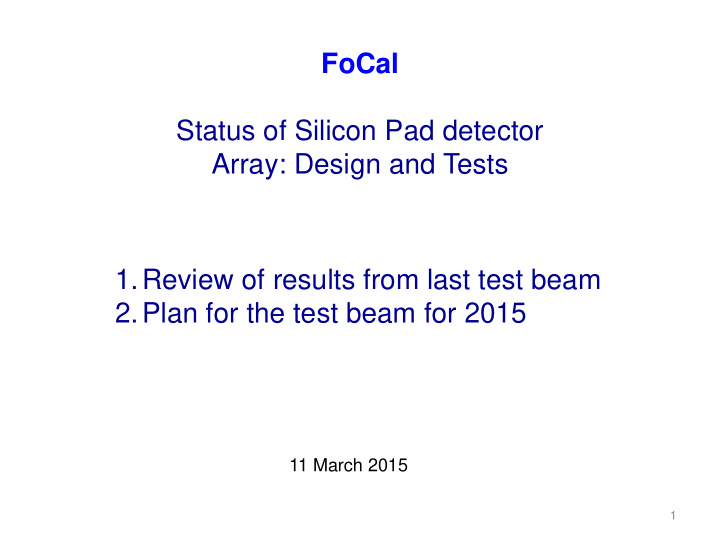



FoCal Status of Silicon Pad detector Array: Design and Tests 1.Review of results from last test beam 2.Plan for the test beam for 2015 11 March 2015 1
Test and Characterization of a Prototype Silicon-Tungsten Electromagnetic Calorimeter VECC, Kolkata :: Sanjib Muhuri, Shuaib Ahmed Khan, Tapan K. Nayak, Rama Narayana Singaraju, Satyajit Jena BARC, Mumbai :: Sourav Mukhopadhay, Vinay B. Chandratre, Maneka Sukhwani and BEL, Bangalore Published in “ Nuclear Instruments and Methods in Physics Research A 764(2014)24 – 29.
Silicon Pad 5x5 Arrays Each pad: 1cm 2 Laboratory set up: Layout of a 5*5 array of 1cm*1cm Silicon Detector 28 October 2014 Sanjib Muhuri, IWAD 2014, VECC 3
Laboratory set up and results PMT1 Source- Sr90 PMT 2 Very thin scintillator to get 2 fold triggers Arrangement for the laboratory experiment 28 October 2014 Sanjib Muhuri, IWAD 2014, VECC 4
Development of the mini prototype Test Beam set up: Arrangement at T10 28 October 2014 Sanjib Muhuri, IWAD 2014, VECC 5
Results From Test Beam Experiment: Responses from am minimum ionizing particle 28 October 2014 Sanjib Muhuri, IWAD 2014, VECC 6
Responses from electron ADC ADC 28 October 2014 Sanjib Muhuri, IWAD 2014, VECC 7
Actual Signal pions & electrons 4 GeV pions Satisfactory Signal to noise separation electrons 28 October 2014 Sanjib Muhuri, IWAD 2014, VECC 8
Longitudinal Shower Profile Reconstruction 28 October 2014 Sanjib Muhuri, IWAD 2014, VECC 9
To check The Linearity of the detector… Shows good linear behavior with respect to the simulation 28 October 2014 Sanjib Muhuri, IWAD 2014, VECC 10
36 element Silicon Pad detector 1 sq cm silicon pads in 6 × 6 array.320 microns. common n. Bias applied negative to p type pads. Signals from p type pads through capacitors. Bonding diagram for pads .
Detector assembled on the PCB Guard rings 40 pin connector left floating for signals Wire bonds from pads Bias resistors and coupling capacitors Guard ring position one corner Before wrapping in a black sheet and Al foil
Testing Test Setup Mapping of Pads to DAQ Channels for one position PMT2 19 10 17 14 12 8 Detector ? 20 16 11 9 18 PMT1 22 24 13 5 4 21 0 25 26 15 ? X 27 30 X X 28 ? Backplane FEE Board 31 29 X 7 23 1 PCB Translator Board Numbers inside the squares are DAQ channels. 2 fold from PMTs is trigger to DAQ. 4 channels left out(marked as X), since we can only read Same backplane PCB made for 25 elements. 3 channels bad on FEE board. Fig needs minor correcti MANAS/ANUSANSKAR readout.
RMS study with Bias 4 detector pcbs can be connected to one backplane PCB. Read by 2 FEE boards. 2 detector PCBs are read by one FEE(64 channels). Connected only detector PCB to backplane PCB. So only 32 channels (0 to 31) show higher RMS compared to other 32(32 to 63) RMs is high at bias 0v and decreases with increasing bias voltage. Stabilizes >45V. Few times rms has gone bad for some channels. Mean adc values have gone down to zero. See next 2 @30V @45V @0V @60V @70V @80V
Pedestal Study-1 On 21.08.13 @30V @0V Mean ADC values for some channels have gone down- channels above colored circl Suspect humidity- The silicon gels have gone pale. @45V @60V
Pedestal Study-2 0n22.0813 @0V @30V Mean ADC values for all channels have normal values. None close to zero Kept the detector inside desiccators with new silicon gels over night. Humidity in the lab also more due to rains.. @45V @65V
First signals
Status and plans for the test beam (PS and SPS) • A new PCB for Silicon pad detectors is being made • Pad detectors to be mounted on the PCB • Prepare the readout with MANAS and ANU chips • Prepare the tower • Present tower design is 4 Si-pad detectors in each plane • Tests can be done with single Si-pad detector in each plane or with 4 Si-pad detectors in each plane • We have 25 tungsten plates (10 cm x 10 cm) • We can organize properly to gain maximum information during the tests • Provision for inserting MAPS detector in between ….
Arrangement for the Test Beam – Oct 2015 4 tungsten plates: each 10cm x 10 cm 4 Pad detectors: each 6x6 array Each pad: 1cm x 1cm
Recommend
More recommend